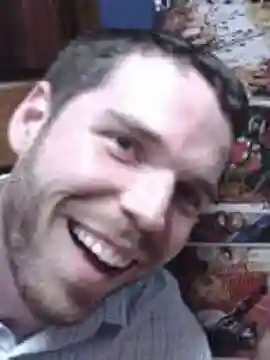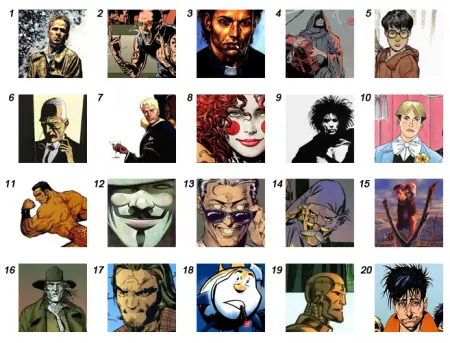DC Comics’ Vertigo imprint was once the shining jewel of mainstream comic books. Launched in 1993, it was presupposed by Alan Moore’s dark and complex Saga of the Swamp Thing in 1984, and that continued with the “British Invasion” of Jamie Delano’s Hellblazer, Grant Morrison’s Animal Man, and especially Neil Gaiman’s The Sandman. Today these comics are canonical examples of comics growing up.
In 2016, however, the shine has worn off. A recent “restructuring” has seen Shelly Bond, who took over for the heralded Karen Berger in 2012 under questionable circumstances, leave her position as Vice President and Executive Editor of Vertigo. The only explanation given in a press release is that DC is “reexamining the direction and focus of the Vertigo imprint of comic books and graphic novels,” and that ambiguity doesn't bode well for the struggling company.
Even more damning, however, is Gerard Way of the band My Chemical Romance and comic The Umbrella Academy running Young Animals, a new DC Comics mature imprint starting this fall. The line, consisting of Doom Patrol, Shade, The Changing Girl, Cave Carson Has a Cybernetic Eye and Mother Panic, looks remarkably similar to Vertigo at its inception.
What this means for Vertigo remains to be seen, but it appears to have been made obsolete. What started as a shared universe became a paradise for insular, experimental properties in the 1990s and 2000s, with creators emboldened by editorial’s laissez-faire attitude. Without a new generation of critical darlings, however, like Preacher, 100 Bullets and Y: The Last Man, the future remains unclear.
The nail in the coffin was the August 2011 New 52 reboot. Those characters (Swamp Thing, John Constantine, Animal Man and others) that had grown apart from DC were now restored, bumping shoulders with and sometimes working alongside the likes of Superman and Batman. Consequently, the only ongoing series that still exists within the same world as Morpheus and Tim Hunter is Lucifer.
Writer Holly Black has the character in a very different place than where Mike Carey left him a decade ago, but there’s no denying this is the Lucifer that abandoned Hell in “Season of Mists”. All signs point to the character only getting priority because of the Fox television series (that barely even resembles the comic book counterpart), much like prequel graphic novel Sandman: Overture came to be due to Gaiman's clout as a writer. These decisions appear to be blips on the radar rather than an attempt at driving the line forward as a whole.
What is evident is that attitudes have changed. What was once a breeding ground for young punks and rebellious artists has been eclipsed by the likes of Image Comics, with the politically-charged Bitch Planet; and IDW Publishing, with prestige horror like Locke & Key. So what went wrong? The answer lies in last year’s release of Free Country: The Children’s Crusade, a collection and completion of the decades-old mini-series that is both the purest distillation of Vertigo at its peak and a demonstration that the old energy just can’t be recaptured.
The Children’s Crusade was a 1993-1994 two-issue mini-series. The first issue was written by Neil Gaiman and the second by Gaiman, Alisa Kwitney, Jamie Delano and Toby Litt, and they bookended five annuals: Black Orchid, Animal Man, Swamp Thing, Doom Patrol, and Arcana. The crossover wasn’t coordinated very well, however, and the tie-in issues barely connected. 21 years later the trade paperback includes a new “middle act”, written by Toby Litt and Rachel Pollack with art by Peter Gross and Al Davison.
On the surface, said lack of coordination seemed a given with this crowd. The crossover wasn't looked upon fondly, as it had become a mainstay of mainstream comic books and was usually utilized to prop up sales and advertise for upcoming new comics. But according to the event's editor Lou Stathis it was anything but:
It's no marketing ploy – that is, it wasn't dreamed up by sales-horny edit-suits, but actually the books' writers [Neil Gaiman, Rachel Pollock, Dick Foreman, Alisa Kwitney, Jamie Delano, John Ney Rieber, and Nancy Collins]. Which means it's a story-driven Event and therefore should (hopefully) satisfy needs other than our burning corporate desire to have you buy more books that you might've otherwise.
This quote was retrieved from a 2005 Sequart article by Robert A. Emmons, Jr. entitled “DC/Vertigo's The Children's Crusade: Child Culture and Reflexivity, Suggested for Mature Readers” from their Anatomy of the Crossover series. As Emmons points out, the event “did not yield smashing results, or critical acclaim within the comics community.” It's rushed and full of plot holes, hardly coheres and suffers from too many cooks. There's a reason why it wasn't collected for so long, but that doesn't mean it's not worth a critical re-evaluation.
The story itself picks up on the theme that had been building at Vertigo of child protagonists, in this case Edwin Paine and Charles Rowland, the Dead Boy Detectives, from Sandman; Suzy, the Black Orchid; Maxine Baker from Animal Man; Tefé, the daughter of Swamp Thing; Dorothy Spinner of Doom Patrol; and most importantly, Timothy Hunter. Tim Hunter is both notorious and somewhat forgotten in comics circles for a few reasons.
He was first introduced in Neil Gaiman's four-issues mini-series The Books of Magic (1990) that worked as a kind of unified field theory for the darker corners of the DC Universe at the time. This was, of course, before Vertigo was official and so the ties were still there. Swamp Thing and Hellblazer shared DNA, and the first volume of Sandman had guest appearances ranging from the original titular character to Scott Free to the Martian Manhunter.
So The Books of Magic attempts to bring this all together as a whole, with 12-year-old British boy Tim meeting Constantine, the Phantom Stranger, Doctor Occult and Mister E. They tell him he is destined to be the most powerful mage in history, and take him on a journey through the past, present, Faerie and future, traversing the magic world as both education and warning. He meets Zatanna, the Spectre, Doctor Fate, Jason Blood and many, many others, and somehow Gaiman makes it all coalesce with gentle attention and obvious love.
At this point it must be mentioned that Tim Hunter is a young boy that wears glasses, has a pet owl, and after the events of the series goes off to a wizarding school. Although this was all seven years before Harry Potter, Gaiman and J.K. Rowling settled long ago that the similarities are mere coincidence, probably stemming from the authors' similar upbringing. This also led to Mike Carey's incredibly entertaining and thought-provoking The Unwritten series from Vertigo that ran from 2009 to 2015 that, with its Tommy Taylor character, examined these archetypal similarities and much more.
The same care and affection on the pages of The Books of Magic is evident in The Children’s Crusade, showing Gaiman’s craft even under the most mercenary of instances as an editorially-mandated crossover. It seemed dubious at first, as Gaiman puts it in the introduction to the hardcover collection: “It started in a hotel, and all the Vertigo writers and editors were there on a mysterious rural retreat. It seemed unlikely to me, like herding cats. We didn't flock together naturally, but perhaps this would be our opportunity.”
And against all odds, this clunky endeavor is both engaging and a novelty. See, this is the only other time besides the original The Books of Magic that Gaiman wrote Tim Hunter, and the attachment is felt in how relatable and approachable the character is. He isn't all that fond of the situation he's in, and isn't impressed by comic book hijinks.
But he's not even the main character and not what makes The Children's Crusade special. The Dead Boy Detectives are the breakout characters, and why it’s clear even with the collaboration that Gaiman is the showrunner. Aside from a Sandman Presents series by Ed Brubaker in 2001 and a manga-style graphic novel by Jill Thompson in 2005, this is their most notable appearance. Gaiman is able to tap into some real child-like wonder with these two, as they serve as audience surrogates investigating 40 missing children from the small village of Flaxdown. The two are a lot of fun together, like naïve Hardy Boys with a dash of gallows humor, and their mix of bumbling and actual competence is endearing.
Their investigation of the children, who have been whisked away to a magical land known as Free Country that can only be made whole by the power of the five paranormal Vertigo children, is seamlessly woven with history, real and fanciful, of the Children's Crusade. Although it's hard to believe, 50,000 children from all across Europe marched to Versailles in 1213 intent on taking back the holy lands with their purity and were never seen again. Gaiman weaves this in cleverly enough with Robert Browning's poems “The Pied Piper of Hamelin” and “Childe Roland to the Dark Tower Came”. It all made for a pat little story even if it felt like it lacked a second act because, as Gaiman put, “bits of plot that had been handed out to the other books weren't actually in those books when they were done.”
Unfortunately, the attempt by writers Litt and Pollack and artists Gross and Davison to inject a second act does not work, and perhaps it's because the old alchemy is impossible to replicate. It was the aforementioned Shelly Bond's idea, having pondered the problem for years, but the results feel overly verbose, with the “villains” sitting around explaining their plans in clunky and unnecessary ways. Actually seeing the five children tricked into Free Country is completely uneventful. Litt and Pollack can't rekindle the distinctive British whimsy and fairytale darkness of the original text. Gross, even having written and drawn Tim Hunter in The Books of Magic ongoing, and Davison have put images to page that feel both overly cartoony and lacking in detail enough to capture the correct tone that is underpinned with dread but reads like a nursery rhyme. Perhaps the whole thing was doomed from the start.
Who knows what lies ahead for Vertigo. They can't recreate the past, as Free Country certainly demonstrates. They've lost most of the old talent, both writers and now editors. New titles get canceled after two months, and the classic characters are being held ransom by superheroes. Now Way is coming along with his hip and fresh new Young Animals, threatening to do exactly what Vertigo can't anymore: make the weirdoes cool again.

About the author
A professor once told Bart Bishop that all literature is about "sex, death and religion," tainting his mind forever. A Master's in English later, he teaches college writing and tells his students the same thing, constantly, much to their chagrin. He’s also edited two published novels and loves overthinking movies, books, the theater and fiction in all forms at such varied spots as CHUD, Bleeding Cool, CityBeat and Cincinnati Magazine. He lives in Cincinnati, Ohio with his wife and daughter.








